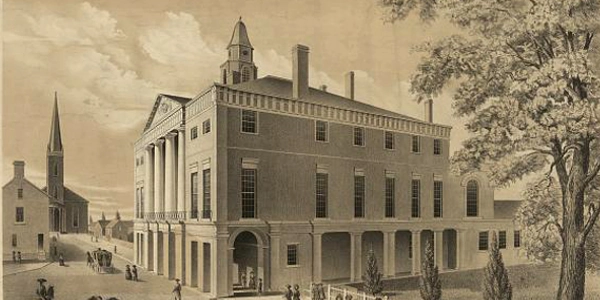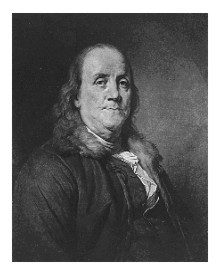
Top: George Washington. Commander of the Continental Army and 1st President of the U.S.A. Courtesy NARA. Right: Surrender at Yorktown. Courtesy Library of Congress.
Sponsor this page for $100 per year. Your banner or text ad can fill the space above.
Click here to Sponsor the page and how to reserve your ad.
-
Timeline
1789 Detail
March 4, 1789 - In Federal Hall, New York City, a converted Customs House, the government of the United States under the United States Constitution begins to act. The U.S. Constitution is declared to be in effect.

The members of the First Congress, Representatives and Senators from the thirteen colonies who made it to New York City after traversing the poor roads of the colonies, met in Federal Hall, New York City, on March 4, 1789 and pronounced that the United States Constitution was in effect. It was basically all they could accomplish, and perhaps doubtful, without a quorum that they could do that either. So why didn't they just postpone the date? It had been chosen at the end of the Confederation Congress in September 1788 upon ratification of the Constitution by the necessary nine states, and with the Articles of Confederation ending, needed to establish the convening date of first governance under the U.S. Constitution.

Minutes of March 4, 1789 - House of Representatives
Wednesday, March 4, 1789
This being the day fixed for the meeting of the new Congress, the following members of the House of Representatives appeared and took their seats, viz:
From Massachusetts, GEORGE THATCHER, FISHERS AMES, GEORGE LEONARD, and ELBRIDGE GERRY.
From Connecticut, BENJAMIN HUNTINGTON, JONATHAN TRUMBULL, and JEREMIAH WADSWORTH.
From Pennsylvania, FREDERICK AUGUSTUS MUHLENBERG, THOMAS HARTLEY, PETER MUHLENBERG, and DANIEL HEISTER.
From Virginia, ALEXANDER WHITE.
From South Carolina, THOMAS TUDOR TUCKER.
A quorum of the members not being present, the House adjourned until to-morrow at eleven o'clock.
Minutes of March 4, 1789 - Senate
Wednesday, March 4, 1789
This being the day for the meeting of the new Congress, the following members of the Senate appeared and took their seats:
From New Hampshire, JOHN LANGDON and PAINE WINGATE.
From Massachusetts, CALEB STRONG.
From Connecticut, WILLIAM S. JOHNSON and OLIVER ELLSWORTH.
From Pennsylvania, WILLIAM MACLAW and ROBERT MORRIS.
From Georgia, WILLIAM FEW.
The members present not being a quorum, they adjourned from day to day, until
A quorum was finally reached in the House of Represenatives on April 1. Their first acts were to choose a Speaker of the House; the majority of the votes chose Frederick Augustus Muhlenberg from Pennsylvania. A Clerk was also chosen; John Beckley. The Senate reached the required number on April 6; they had previously sent out two circulars to absent members requesting their attendance. On that date, they chose a President, John Langdon of New Hampshire, for one purpose, counting the votes for President of the United States. Electors for the Electoral College had been chosen in each state between December 15, 1788 and January 10, 1789; each elector would cast two votes at the meeting of the Electoral College on February 4, 1789. Ten states participated. New York did not send a slate of electors and Rhode Island and North Carolina had not yet ratifield the Constitution and therfore were not eligible. The man with the majority of the votes would become President; the man with the second most votes, not needing a majority, would become Vice President.
A notice was sent to the House of Representatives that the Senate now had the necessary members for a quorum and that the House should proceed to the Senate chambers.
"Mr. ELLSWORTH reported that he had delivered the message; and MR. BOUDINOT, from the House of Representatives, informed the Senate that the House is ready forthwith to meet them, to attend the opening and counting of the votes of the electors of the President and Vice President of the United States.
The Speaker and the members of the House of Representatives attended in the Senate chamber; and the President elected for the purpose of counting the votes, declared that the Senate and the House of Representatives had met, and that he, in their presence, had opened and counted the votes of the electors for President and Vice President of the United States, which were as follows:"
George Washington received 69 votes, a unanimous number from the sixty-nine electors, John Adams 34, thus making them President and Vice President. Others with votes; Samuel Huntingdon 2, John Jay 9, John Hancock 4, Robert H. Harrison 6, George Clinton 3, John Rutledge 6, John Milton 2, James Armstrong 1, Edward Telfair 1, and Benjamin Lincoln 1.
The Senate appointed two men to notify Washington and Adams of their positions. George Washington would be inaugurated three weeks later on April 30, 1789.
Photo above: Federal Hall, New York City, circa 1879, Cornelius Tiabout. Courtesy Library of Congress. Below: Mount Vernon, date unknown, Historic American Buildings Survey. Courtesy Library of Congress. Sources: A Century of Lawmaking for a New Nation: U.S. Congressional Documents and Debates, 1774 - 1875
Annals of Congress, Library of Congress; Senate.gov; mountvernon.org; Wikipedia Commons; Federal Hall National Historic Site.








